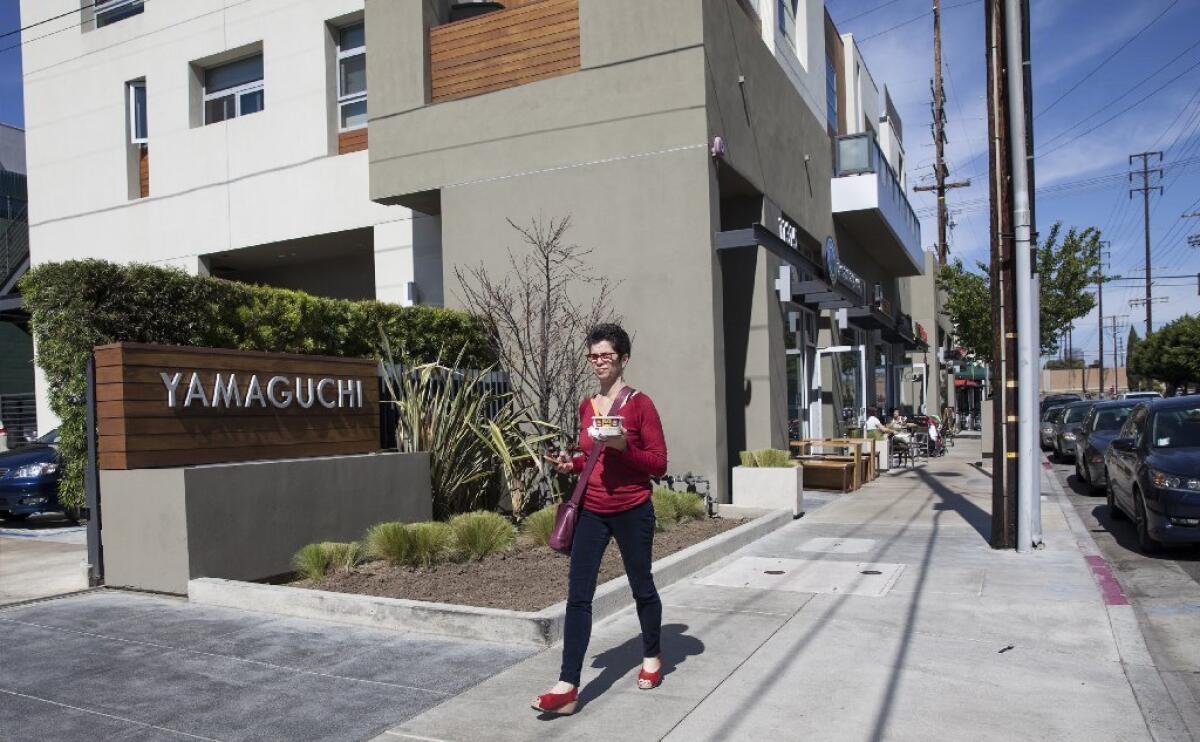West L.A. neighborhood to be recognized as ‘Sawtelle Japantown’

- Share via
Life along Sawtelle Boulevard circa 1960 was a lark for 7-year-old Sandy Toshiyuki.
If she wanted a hamburger or tacos at the nine-stool Ketchie’s stand or a loaf of Weber’s bread from Safe & Save Market, she would simply say: “Charge it.” On the first of every month, her father, the local druggist, would walk up and down the boulevard settling her accounts.
“It was that kind of Mayberry existence,” said Toshiyuki, now 62 and a resident of Venice.
Ketchie’s was demolished by an errant pickup truck nearly 30 years ago, and the tranquil small-town ambiance has similarly been obliterated in the West Los Angeles Sawtelle neighborhood, where Japanese Americans banded together before and after World War II, with years in internment camps in between.
Known informally as Little Osaka, to distinguish it from downtown Los Angeles’ Little Tokyo, the enclave has evolved into an eclectic haven for hipsters and devotees of Pan-Asian food. Commercial rents are soaring. Artsy and tech-oriented Millennials — including Michelle Phan, the style blogger and YouTube sensation — have taken up residence in contemporary apartments that have risen in place of nurseries and bungalows.
Fearing that Sawtelle was rapidly losing its identity, a grassroots community group last year began pushing the city to acknowledge the area’s distinctive history. At noon Sunday, Councilman Mike Bonin will join leaders of three venerable Japanese churches and the Japanese Institute of Sawtelle to unveil signs marking the area as “Sawtelle Japantown.”
“The thing that got this effort going was the past,” said Randy Sakamoto, 68, a Sawtelle historian. “People were forgetting there was a Japantown and how strong it was. I told them: ‘We’re at least going to put up a sign so people in the future will know it was here.’”
Japanese immigrants began settling in the early 1900s in Sawtelle (or soh te ru, as they called it), where barley and celery were farmed in open fields. Restrictive covenants and overt resistance by white residents prevented them from living in communities such as Westwood, Bel-Air and Brentwood —though many labored in the gardens of those areas’ well-to-do white inhabitants.
Sawtelle’s Japanese Americans were among those the U.S. government sent to Manzanar and other internment camps during World War II. After the war, many returned to re-establish Sawtelle as a thriving, self-contained district with its own fish markets, noodle shops and auto-repair garages.
“People formed a community here and developed a credit union system to raise capital for buying property,” said Jack Fujimoto, a longtime community leader. “It was kind of like a commune.”
Midori Yamaguchi opened an eponymous variety store in the 1950s, and her son Henry, 84, recalls helping amid the shelves filled with fabric, calligraphy brushes, rice paper and sweets. Youngsters would hang out in the candy aisles while playing hooky from Japanese language and culture classes at the institute.
A few years ago, Yamaguchi sold the property, at the corner of Sawtelle and Mississippi Avenue, to Manny Salzman, who came to West Los Angeles as a teenager from Uruguay and began frequenting Sawtelle’s restaurants and shops in the mid-1980s.
Salzman built nine roomy apartment units atop several commercial spaces and named the complex Yamaguchi in honor of the beloved store and family.
Two trendy eateries — ROC Kitchen (dumplings and other Taiwanese specialties) and Seoul Sausage Co. (Korean fusion) — are among his ground-floor tenants.
Nearby, David Owen Taylor is developing two 3,000-square-foot custom homes that he’ll call the Osaka Residences and hopes to sell for about $2 million each. One inquiry about the property, he said, came from a brother and sister who sold their Brentwood compound and “want to be where the action is — sushi and noodle shops.”
The area’s transformation has been a mixed blessing. Side streets back up with traffic on busy days. Parking is at a premium.
Amid the changes, Ronald Kageyama, 52, is holding firm to some of the old ways. He lives next door to and works at FK Nursery on Colby Avenue, founded by his grandfather in 1936.
“I like that it’s progressing,” he said of his lifelong neighborhood, “but I think it’s sad that a lot of the old feel is gone.”
Twitter: @MarthaGroves
More to Read
Sign up for Essential California
The most important California stories and recommendations in your inbox every morning.
You may occasionally receive promotional content from the Los Angeles Times.











